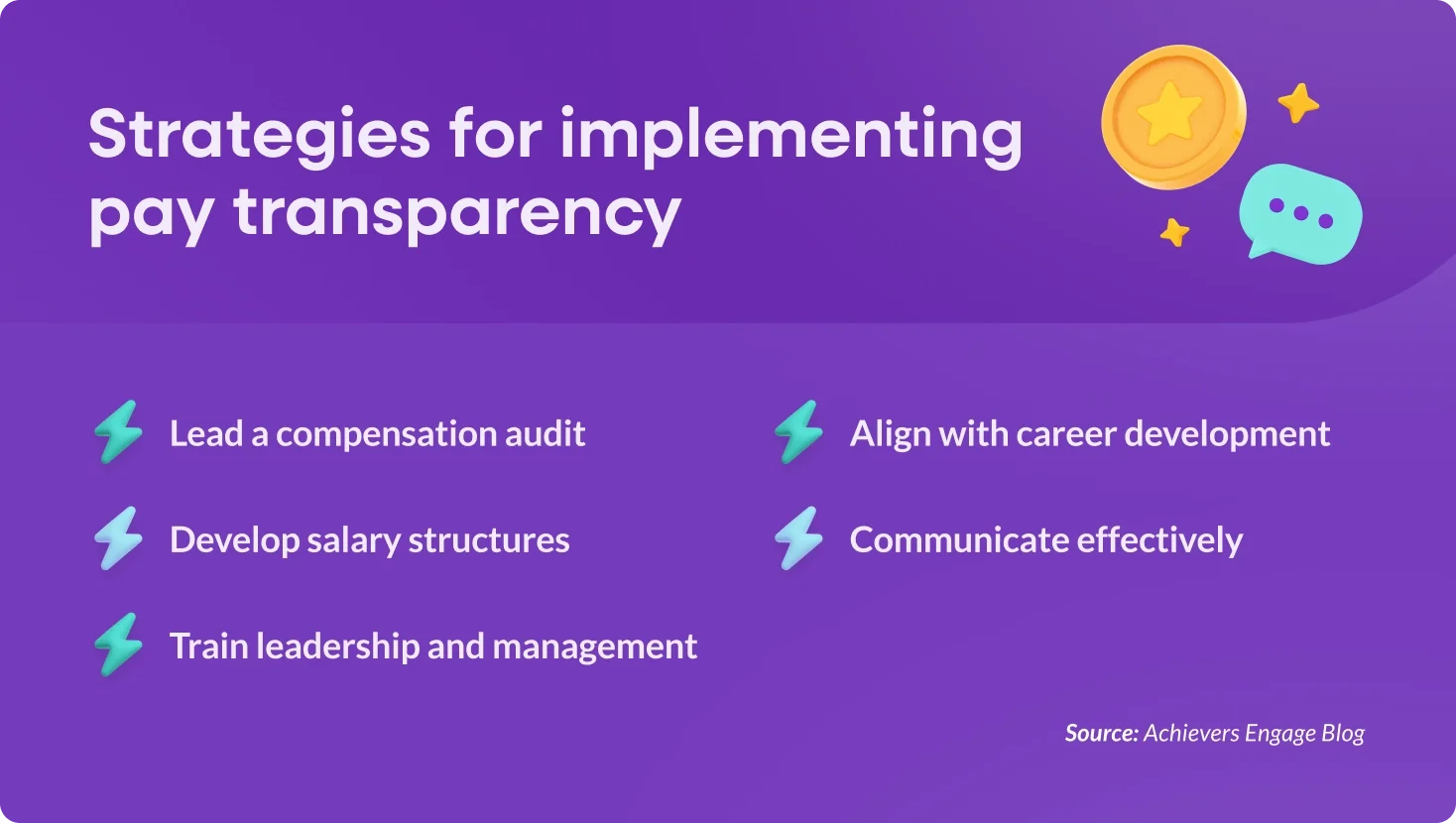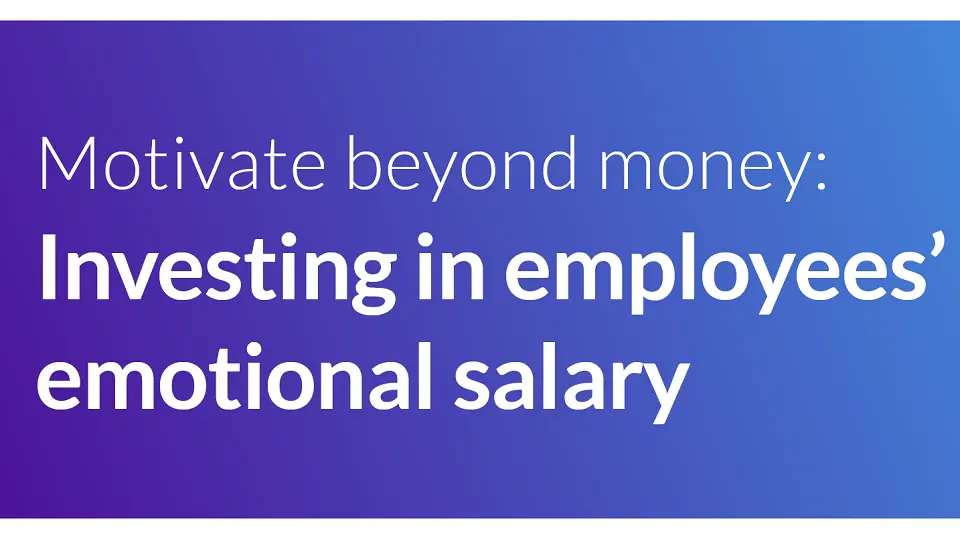Table of contents
Talking about salary has long been considered taboo in the workplace, but today pay transparency is the norm. Employees want to know how salaries are set and whether they’re being paid fairly. In fact, 58% of workers tell Business.com they would prefer to work for a company that publishes salary information publicly.
But transparency shouldn’t stop at salary. It’s part of the larger picture — organizational openness, where employees feel informed, valued, and treated equitably. When companies embrace transparency — not just in pay, but in feedback, recognition, and career development — they build trust, boost engagement, and create a stronger culture.
So, how can organizations implement pay transparency effectively? And what steps can HR leaders take to create a company culture that goes beyond compensation? In this guide, we’ll explore the benefits, challenges, and best practices to make transparency a lasting part of your workplace.
What is pay transparency?
At its core, pay transparency is about openness around salaries and how pay decisions are made. But not every company takes the same approach. Some share only the basics, while others go all in.
- Basic transparency: Employees get a general sense of pay ranges, but individual salaries stay private.
- Structured transparency: Salary bands and pay criteria are clearly outlined, so employees know what to expect.
- Full transparency: Everyone knows what everyone makes; an approach that promotes openness but requires careful planning.
Finding the right balance helps companies build trust while keeping compensation fair and competitive.
Why pay transparency matters in the modern workplace
Pay transparency isn’t just about numbers; it’s about trust. When employees understand how salaries are determined, they feel valued and treated fairly. Transparency reduces pay gaps, fosters a culture of fairness, and strengthens retention.
In the simplest terms, open conversations about pay create a more engaged, motivated, and loyal workforce.
The benefits of pay transparency
Talking about pay used to be off-limits, but today, employees expect openness. When companies are clear about how salaries are determined, employees feel valued, motivated, and more likely to stick around. And the benefits don’t stop there. They include:
- Building trust and fairness: Transparency creates a level playing field, ensuring employees understand how pay decisions are made. When organizations openly share salary structures, they help close gender and racial wage gaps, reinforcing their commitment to equity. Employees who see fairness in action are more likely to trust leadership and stay engaged.
- Increasing engagement and morale: When employees know where they stand and how they can grow, motivation soars. Transparent pay structures remove uncertainty and foster a culture of recognition and appreciation — key factors in boosting morale and workplace satisfaction.
- Attracting and retaining top talent: Pay transparency helps companies attract and retain top talent by signaling fairness and trust. Job seekers are drawn to organizations that openly share salary structures, while employees who understand how their pay is determined are less likely to leave due to uncertainty.
- Enhancing organizational performance: Employees who trust the system are more engaged, more productive, and more likely to contribute to a positive workplace culture — ultimately driving better business outcomes.
Challenges in implementing pay transparency
While pay transparency offers several benefits, there are some challenges to overcome. Leaders might have concerns, and employees may not always react as expected. Finding the right balance between transparency and privacy, while ensuring communication is clear, is key to making this shift successful.
- Leadership hesitation: Leaders often worry that sharing salary info will cause tension or dissatisfaction. To address this, focus on the long-term benefits, like building trust and increasing engagement. Start by sharing broad salary ranges and explain how compensation decisions are made.
- Employee reactions: Employees might feel uneasy, especially if they discover pay gaps. To manage this, set clear expectations from the start, explain why differences exist (e.g., performance, experience), and be prepared for open, honest discussions.
- Balancing transparency with privacy: Transparency shouldn’t come at the cost of individual privacy. You don’t need to show exact salaries for everyone. Instead, focus on sharing salary ranges or pay bands that give employees a sense of fairness without compromising personal information.
- Ensuring consistency: To avoid confusion, consistent communication is essential. Regularly update employees about transparency practices and make sure everyone understands how pay is determined. Use clear, easy-to-understand guidelines so no one is left in the dark.

Strategies for implementing pay transparency
Implementing pay transparency requires thoughtful steps to ensure fairness, clarity, and buy-in from both leadership and employees. Here’s how to get started:
Step 1: Lead a compensation audit
Start by taking a close look at your current pay structure. Are there any pay gaps? Is your compensation in line with market standards and internal equity? A thorough audit helps you spot areas that need improvement and ensures no employee is unintentionally underpaid or overlooked.
Step 2: Develop clear salary structures
Create salary bands that reflect different roles, experience levels, and locations. Be transparent about how these bands are set and make them accessible to your employees. Don’t forget to set expectations around raises, bonuses, and promotions so employees know what they can achieve and how to get there.
Step 3: Train leadership and management
Managers are key in fostering a culture of pay transparency. Provide them with the right tools and training to have open conversations about compensation with their teams. Equip them with the language to explain how pay decisions are made and help them understand the positive impact of transparency on morale and employee engagement.
Step 4: Align with career development
Only 25% of employees surveyed say their company promotes from within for senior positions, according to Achievers’ 2024 Engagement and Retention Report. Set clear guidelines for promotions and raises that are linked to performance, milestones, and long-term development. This gives employees a roadmap to advance, knowing that their efforts will be recognized and rewarded.
Step 5: Communicate effectively
Consistent and transparent communication is key to keeping employees engaged and informed. Regularly update your team on transparency efforts through town halls, newsletters, or intranet posts. Make sure there’s an open-door policy for pay discussions, so employees feel comfortable raising concerns and providing feedback.
Pay transparency: Myths vs. reality
Despite its benefits, pay transparency is often misunderstood. Here are some common misconceptions and the truth behind them:
1. Myth: Pay transparency means revealing everyone’s salaries
Reality: Transparency doesn’t mean sharing individual salaries. It’s about clear pay structures and fair compensation frameworks.
2. Myth: It will create conflict among employees
Reality: When done right, transparency reduces uncertainty and builds trust rather than fueling resentment.
3. Myth: It limits flexibility in compensation
Reality: Transparency explains how pay decisions are made while still allowing room for performance-based rewards.
4. Myth: Only large companies can implement pay transparency
Reality: Businesses of all sizes can adopt transparency at various levels, improving trust and fairness across the board.
How to make sure transparency doesn’t stop at salary
Introduce the idea that pay transparency should extend beyond just salary to include recognition, rewards, and employee feedback.
True transparency involves not only visible compensation but also ensuring that contributions are fairly recognized, rewards are personalized, and employees have a voice in shaping company culture.
Here’s how you can ensure transparency doesn’t stop at salary:
- Extend transparency: Don’t just share salary info — highlight employee achievements. Recognizing contributions openly creates a culture where people feel valued, not just for their pay but for their impact.
- Ensure equity: Have a structured recognition program that offers points-based rewards based on employee contributions, not just compensation. This ensures everyone feels appreciated, no matter their role or background.
- Listen to employees: Use surveys or employee feedback tools to understand how people feel about your recognition practices. It keeps you in tune with their needs and ensures your approach stays transparent and inclusive.
Create a culture of transparency with Achievers
While pay transparency is an important first step, it’s just the beginning of building a workplace where employees feel valued and connected. True transparency goes beyond salary. It’s about building an ongoing culture of recognition, trust, and engagement.
Achievers helps HR leaders build that culture. Our employee recognition platform integrates real-time recognition, personalized rewards, and employee voice solutions to create an environment where transparency thrives.
Our platform’s real-time data and analytics offer valuable insights into employee recognition, engagement, and sentiment. These tools empower HR leaders to maintain transparency throughout the employee experience, from pay and recognition to career development and beyond.



